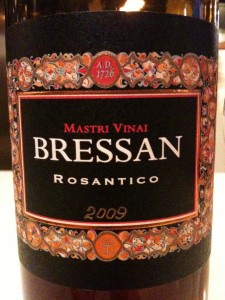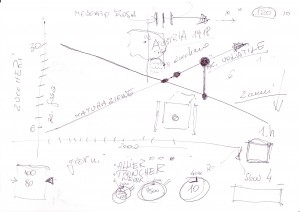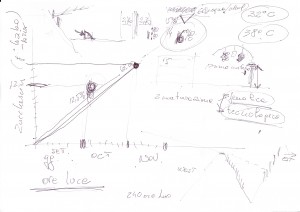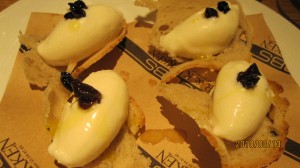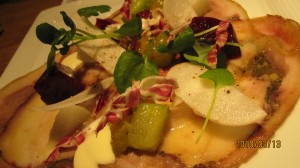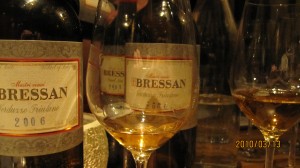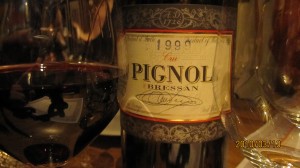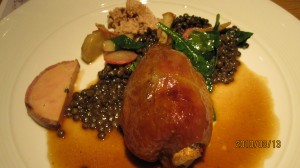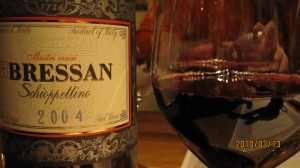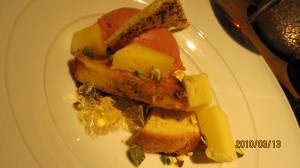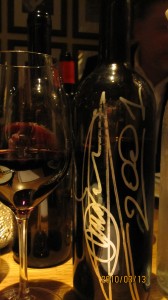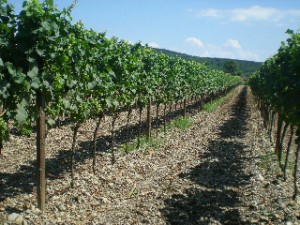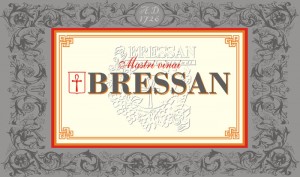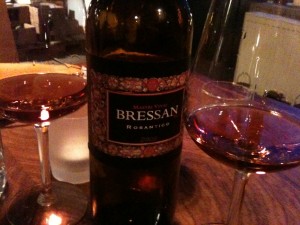
The Moscato Rosa vine has an ancient history dating back to the Austro-Hungarian Empire here in Friuli, hence the clever name on the label. Fulvio Bressan’s family have always had this small (1 HA) vineyard, and Fulvio’s father used to make a sweet wine from the vine, the traditional vinification method for this grape. A rather rich history for this rather difficult little vineyard.
The vineyard had an extremely low yield of about 1500 liters in 2009 for the 1 HA, that’s about 2000 bottles. And that was in a good year. Bressan picks the grapes late to insure ripeness, which is tricky since this grape has a high level of “colatura” or risk of falling off the vine when ripe. But still he waits to pick the grapes late so that they are dry like sultana’s, adding to the risk that botrytis cinerea (noble rot) will set in, which is not desired here. Add these risks together and you have the elements of total vintage loss, which is what happened in the previous 7 vintages! Also no wine was made in 2010 and the 2011 is still in tank fermenting
After the manual harvest, the grapes were pressed and de-stalked. Maceration was for 3 days, fermentation was spontaneous thanks to the ambient yeasts present on the bunches. Alcoholic fermentation lasted for about 4 weeks, followed by an induced (by a small increase in temperature) malolactic fermentation. The wine was then racked and left on the fine lees in stainless steel for two years, giving the grape the chance to show its elegance and personality. The wine was then bottled without filtration. The wine then continued for a bit longer for some bottle maturation. Total alcohol is 13.20% and total acidity is a fresh 6,38 g/l.
Click here for some nerdy information for those who care.
Date tasted: March 3rd, 2012 18:30
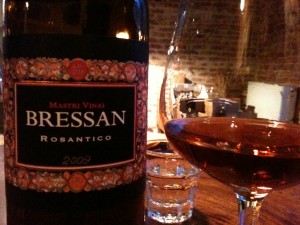 Appearance: Normally I would say “see the photos”, but since the photos i took were in a dimly-lit place, I will try and describe the color. It has more of a light-reddish-copperish color, than of a pure rosé like we might see from southern France. Like a pure extraction of fruit juice. Intriguing for sure. See photo
Appearance: Normally I would say “see the photos”, but since the photos i took were in a dimly-lit place, I will try and describe the color. It has more of a light-reddish-copperish color, than of a pure rosé like we might see from southern France. Like a pure extraction of fruit juice. Intriguing for sure. See photo 
Nose: Wild fruits (berries) and rose pedals, very intense. Hints of floral soap, yes soap.
Palate: Dry. Important to emphasize dry, as in none or very little residual sugar. Texture of a liquor, with the alcohol a bit noticeable but not enough to throw the wine out of balance. I think this aspect of the wine will integrate nicely in the coming years adding to its complexity. Super length and acidity giving this syrupy wine lots of freshness. Really very liquor-like in the texture. Like a syrup made of fresh berries. The after taste had mild yeasty hints, which I liked.
Although enjoyable now, will be enjoyable for years to come for sure. Goodbye today’s rosé and hello rosé for tomorrow!
]]>
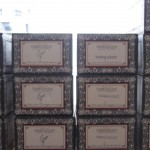
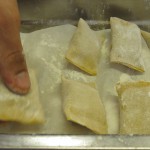 Event: Bressan Wine Maker Dinner
Event: Bressan Wine Maker DinnerRestaurant: Jacob’s Bar & Kjøkken
Date: Saturday, March 13th 2010
Host: Fulvio Bressan, Vinosseur, 213 W Wine Imports
I have done a producer profile on Bressan in past posts, but nothing I have written could have prepared me for such a down to earth warm person such as Fulvio. Energetic and outgoing, Fulvio entertained everyone at our table and the other tables as we made our rounds to introduce him to our guests. I thought I was going to have my work cut out for me with the translating from Italian, but it turns out that Fulvio’s grasp of English is very good, making my job a little easier. The turn out was better than anticipated with a completely full restaurant with even a few tables being turned.. for quaint little Bergen, this is quite a feat!
Bressan not only entertained the guests’ questions, he even managed to sneak over to the bar guests who stopped in after the local football (soccer) game and befriend them! Behind this outgoing, down to earth person, lies an amazing wine maker, even more amazing is his approach to viticulture. Although he is as natural as he can be, their is a lot of science going on here, especially when it comes to harvest. The effect that the harvest of healthy grapes has on the final wine is tremendous! In fact, harvesting even one day “too soon” or one day “too late” can make a significant difference on the final wine. (click on the images below to enlarge)
 Fulvio spoke of how much one or two days effect the maturity of the grape, what climate does to the maturation curve (sugar versus phenolic maturity), volatile acidity relating to date of harvest, and hours of light exposure effecting grape maturity. He even spent a few minutes discussing oxygen exchange differences between different size oak barrels, the smaller the barrel, the thinner the wall diameter, the greater the oxygen exchange (and oak influence). The most important thing to understand here is that most of his science, and the most important part of it, is out in the vineyards – especially when it comes to the exact date to harvest – probably the single most important. He also mentioned that the only thing he does out in the vineyards is the copper and sulfur treatment, but never after the 31st of July. And, he never harvests before it has rained, so that the grapes can be rinsed.
Fulvio spoke of how much one or two days effect the maturity of the grape, what climate does to the maturation curve (sugar versus phenolic maturity), volatile acidity relating to date of harvest, and hours of light exposure effecting grape maturity. He even spent a few minutes discussing oxygen exchange differences between different size oak barrels, the smaller the barrel, the thinner the wall diameter, the greater the oxygen exchange (and oak influence). The most important thing to understand here is that most of his science, and the most important part of it, is out in the vineyards – especially when it comes to the exact date to harvest – probably the single most important. He also mentioned that the only thing he does out in the vineyards is the copper and sulfur treatment, but never after the 31st of July. And, he never harvests before it has rained, so that the grapes can be rinsed.
Enough said, now on to the dinner and the pairings!
****
AMUSE BOUCHE
****
FIRST COURSE
PAIRED WITH
Comments: The delicate dried apricot aromas in the wine matched perfectly with the compote.
****
SECOND COURSE
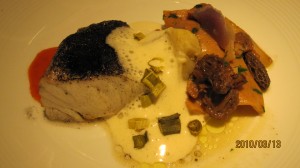
Baked Saithe with Blackened Leek, Crispy Spring Onion, Artichokes and Scallop and Mushroom filled Ravioli
PAIRED WITH
Comments: When I spoke to Fulvio on the phone about pairing his Pignol with a fish dish, he thought we were crazy. When he tasted the dish, he was stunned! The combination of fish, burned leeks and mushrooms created the link between the wine and the dish.
****
THIRD COURSE
PAIRED WITH
Comments: The pepper notes in this wine and good acidity paired especially well with the green lentils and liver
FOURTH COURSE
PAIRED WITH
Comments: Although I rarely use a dry red wine with cheese, this wine was great with the cheese and tomato sorbet (slightly sweet). We got mixed reviews on this dish. Many guests expected the “dessert” to be something sweet, rather this was an Umami filled dish which was for many of us at our table, one of the best pairings of the meal.
]]>
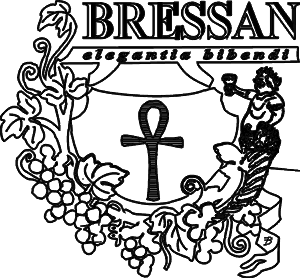 BRESSAN mastri vinai
Via Conti Zoppini, 35
34070 FARRA D’ISONZO (Gorizia)
Italy
Tel. +39 – 0481 – 888131
Fax +39 – 0481 – 889824
E – mail: bressanwines@tin.it
www.bressanwines.com
www.bressanwines.it
BRESSAN mastri vinai
Via Conti Zoppini, 35
34070 FARRA D’ISONZO (Gorizia)
Italy
Tel. +39 – 0481 – 888131
Fax +39 – 0481 – 889824
E – mail: bressanwines@tin.it
www.bressanwines.com
www.bressanwines.it
I haven’t done too many “producer profiles” so far, and I suppose that’s because I really have to believe in the philosophy of the producer before I feel compelled to write about them. Then, I really have to like the wines. I may have a favorite bottle, but overall, I tend to enjoy all of the wines the producer makes. Usually the wines will have a certain signature that says they all belong to a certain family – in this case we’re talking about the philosophy and wines of Mastri Vinai Bressan, and that signature is one of passion and patience. Patience enough to release a wine that, although is certainly age worthy, is actually ready to drink upon release. And this is why I have selected to write about Bressan.
The Bressan family owns about 20 hectares in the Friuili-Venezia Giulia appellation in North-Eastern Italy on the border to Slovenia. The first thing that struck me about this producer was of course the wines. Indigenous varieties that one does not taste every day, such as the Schioppettino, Pignol and Verduzzo Friulano. The second thing that struck me was the vintage of some of these wines which went back as far as 1999 (the latest release of the Pignol, for instance). The third thing that struck me was the philosophy of this producer. A philosophy very much in line with what I feel a wine producer’s philosophy should be.
The philosophy of the producer is very important to me. I focus mostly on wines that are organic, biodynamic and natural. It is not important to me if the producer is certified organic or biodynamic and I have said this before. After all, getting a certification is sometimes done for the wrong reasons. I am not excluding producers that ARE certified, I am just stating that an attitude and philosophy are in my opinion more important.
Fulvio Bressan says the following: ” I am not ‘organic’, even my own personal rules impose conditions in the vineyard and wine-cellar that are more severe than those of various ‘certifications’ “. He adds ” I am not bio-dynamic because I know unfortunately that the rules can be superseded by fashion and I know that nothing is easier than imposing rules and then breaking them, thus profiting from the naiveté of others… ” And, goes on to say ” The majority of wines produced today around the world are made mediocre, deprived of character, standardized, unable to challenge Time due to the indiscriminate use of chemicals both in the vineyard and the wine-cellar. This method of working deadens the traces of the grapevine, the features of the territory and the personality of the producer “. You can read more about his approach and philosophy here. It’s very interesting and worth a read!
And now on to the vines and wines. The wines of Bressan are made using only proprietary grapes. He does not sell or buy grapes. In fact, if the vintage is not a good one, Bressan chooses to simply let his grapes hang on the vines and fall to the floor and back into the soil in which they came. This way, nobody else can say they produce wines with the grapes of Bressan. His neighbors think he’s crazy, but he feels if his name is going to be on the bottle, it needs to be representative of his values. He says he will probably never get rich, but he will always be able to look into the eyes of people he has in front of him.
All the work they do in the vineyards and in the wine cellar is done with the maximum respect for nature, the grapes and the people who drink their wines (“wine should be a medicine not a poison as in many cases”). Here are the rules they have always followed:
- Manual selection of the vines and preferential use of indigenous varieties (cloning and all forms of genetically-modified organisms are forbidden)
- Pruning and removal of shoots is performed exclusively by hand
- Personal cultivation of the vineyard without the use of synthetic chemical substances, respecting vine and its natural cycles (total exclusion of herbicides and/or fungicides and/or pesticides)
- Exclusive use of natural fertilizers, from vegetables or from the barn, or else none at all
- Irrigation is forbidden even as relief, as water has always diluted the aromatic wealth and intensity of the wine
- The harvest is done manually to obtain perfectly healthy and mature grapes (no premature harvesting)
- Fermentation is obtained thanks to indigenous yeasts naturally present in the grape, absolutely excluding the use of synthetic industrial yeasts.
- No sulfurs anhydrides are added to the must, nor are other additives / chemicals (sulfurs anhydrides might be added only in small quantities at the moment of bottling and in any case in quantities that are lower or equal to biological certification)
- The use of biological and/or chemical aromas is forbidden
- Maturation of the wine in its own “fine lees” up to bottling
- No filtration (a practice which in any case always impoverishes and sterilizes the wine)
- Exclusive use of cork, rigorously limited to natural single pieces, so that each wine will have Time as its best ally
- Rigorously manual labeling (… each bottle is a unique creature… )
I will do complete tasting notes on 5 of Bressan’s wines over the next few days, so check back for some exciting wines and tasting notes!! Happy Holidays!!
